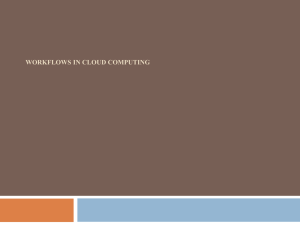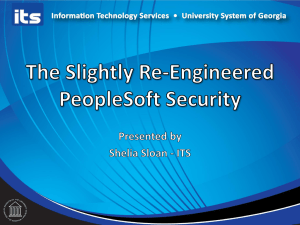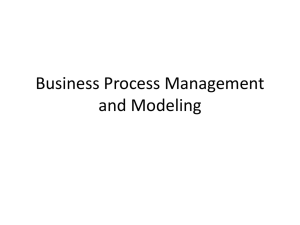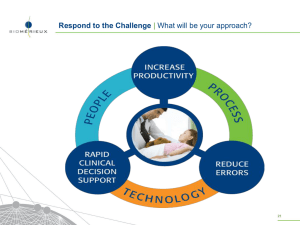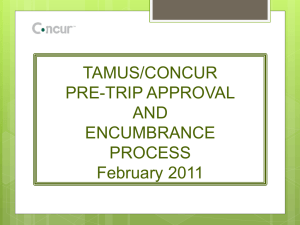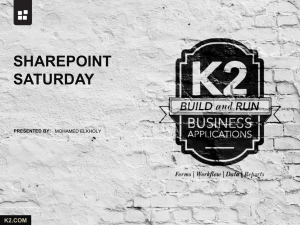PowerPoint Slides - Board of Regents of the University System of
advertisement
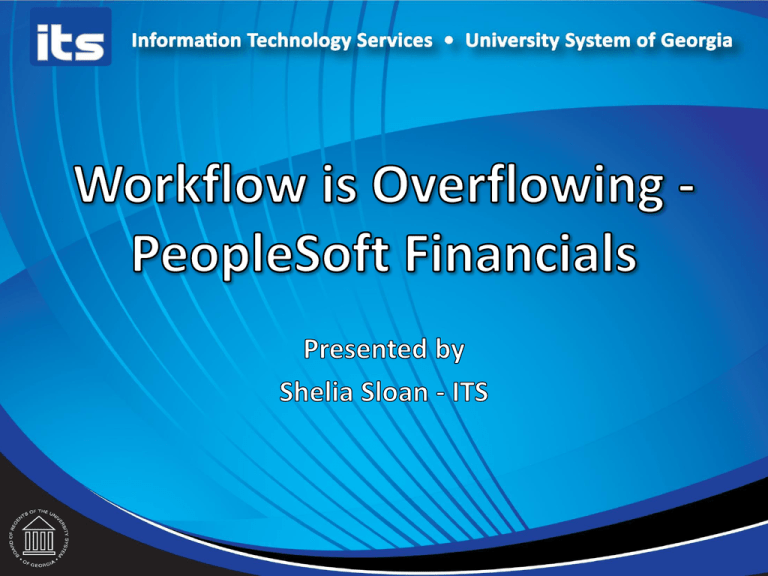
Overview • PeopleSoft 9.2 is loaded with workflow. This session reviews the changes to previously delivered workflow and some of the new workflow that will be available. You also receive information to think about so you can begin planning your institution's workflow setup in 9.2. Overflowing Agenda • What is Workflow • Which Modules will be Utilizing Workflow – Stage Options for Each – Templates for Institutions • What Can the Institution Be Doing Now – Internal Cutoff Dates – State of Transactions • Q&A What is Workflow? • Many of the daily tasks that you perform are part of larger tasks that involve several steps and several people working together. • For example, when you enter an invoice, you are initiating an approval and payment process: someone else reviews and approves it, and a third person submits payment to the vendor. The term workflow refers to this larger process. What is Workflow cont’d • Workflow approval enables transactions that are initiated by End Users, to be routed through the system to pre-defined Approvers. • Each of the Approvers are assigned to a specific workflow approval level. • As the transaction is passed through each workflow approval level, the Approver is responsible for verifying the information on the transaction. What is Workflow cont’d • The actions available to an approver through AF include approve, deny, hold and push back. • Transactions can be approved at the header level, line level, or a combination of the two. All required approvers must approve the transaction to make the status approved. • A denied transaction sends the transaction back to the user who submitted it into workflow. For example, if a requisition is denied, it will be sent back to the requester. • What is Workflow cont’d • Putting a transaction on hold gives the approver time to gather additional information before making the choice to approve or deny and gives others visibility into why a transaction is taking longer than anticipated to flow through workflow. • Push back functionality allows the approver to send the transaction back to the prior approver for additional review. For example, if the approver learned of additional information that they believe the first approver was unaware of, they could send the transaction back. Example of approval level Approvals • Transactions that require approval can be accessed by the approver via the Approver’s Worklist or by going directly into the approval page for the particular transaction. • The approver will be notified via email of any pending transactions that require their approval Worklist Approvals • Approvers can use the User Monitor page to work through pending transactions assigned to them. Individual approvers cannot access other people’s workflow through this page. • The workflow administrator, however, has access to all workflow transactions through the Approval Monitor page. • In addition to the actions available to the approver, the administrator also has the ability to resubmit or reassign the workflow. • This functionality is useful in cases where an approver is changed after the transaction is submitted for approval. User Monitor Page Approvals • Workflow is configurable by institution and can be setup based on certain criteria. • Each Module will have a standard set of delivered approval options that can be selected. • Escalation notices and reassignment days can be controlled at each institution. So What Modules Will Use Workflow in 9.2? ePro Requisitions • ePro Workflow will not change from 8.9 • 5 Stages of Approval – Department/Project Approval – Fund Code Approvals – Amount Approvals – NIGP Code Approvals – Buyer Approval Expense Transactions • Expenses Workflow will not change from 8.9 • 5 Stages of Approval – Department Level 1 Approval – Department Level 2 Approval – Project/Grant Approval – Reviewer – AP Auditor Approval Accounts Payable Transactions • Accounts Payable Workflow will be used in 9.2 • 2 Stages of Approval – Asset Approval – Missing Profile ID • BOR_VOUCHER_ASSET_APPR – Budget Reference Approval • BOR_VOUCHER_BUD_REF_APPR • BOR_AP_ADMINXX Purchasing Transactions • Purchasing Workflow will change from 8.9 • 3 Stages of Approval – Asset Approval – Missing Profile ID • BOR_PO_ASSET_APPR – Budget Reference Approval • BOR_PO_BUD_REF_APPR – Buyer Approval • BOR_BUYER_APPR • BOR_PO_ADMINXX General Ledger Journal Transactions • Journal Workflow will change from 8.9 • 1 Stage of Approval as in 8.9 • Will Use the new Approval Framework in 9.2 to route the transactions • Should eliminate the self approval issues from 8.9 • ROLE is still BOR_GL_JRNL_APPR • New BOR_GL_ADMINXX for workflow admin Commitment Control Budget Journal Transactions • Budget Journal Workflow will be used in 9.2 • 1 Stage of Approval • Will Use the new Approval Framework in 9.2 to route the transactions • BOR_KK_BUD_APPR • BOR_KK_ADMIN71 What Does This All Mean? • Workflow is configurable by business unit • ITS will be sending out templates for approval options for each institution • Each institution is responsible for selecting desired approval stages • ITS will configure those in the UAT environment for UAT testing. Sample Workflow Requirement Doc What Can the Institution Be Doing Now • Define Current Business Process and Requirements for Approving Transactions in Each Area at the Institution. • Map those to the Approval Options delivered by ITS using the stage templates that will be sent out. • Start cleaning up Old transactions. • Set internal cutoff dates for transaction entry closer to go live. Questions? Thank you for attending! University System of Georgia Information Technology Services


